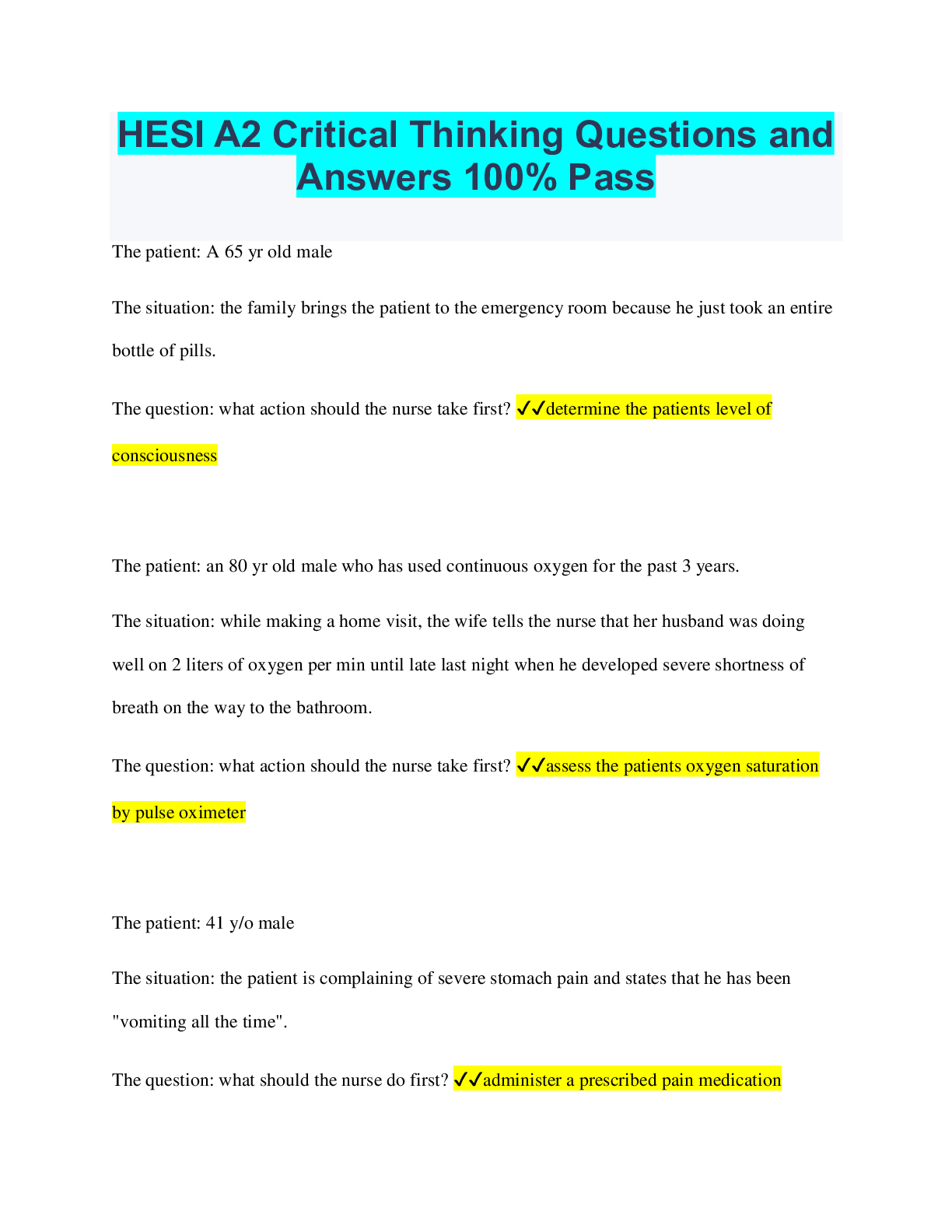Urology > QUESTIONS & ANSWERS > Packrat Questions - Urology (All)
Packrat Questions - Urology
Document Content and Description Below
Packrat Questions - Urology History & Physical/Urology/Renal When performing a rectal examination, prostatic massage is contraindicated in Answers A. prostatodynia. B. non-bacterial prostatitis. ... C. chronic bacterial prostatitis. D. acute bacterial prostatitis. - ANS - Explanations (u) A. Prostatodynia is an inflammatory disorder involving voiding dysfunction and pelvic floor musculature dysfunction. There is no bacterial involvement. (u) B. Non-bacterial prostatitis is similar to chronic bacterial prostatitis, but no bacteria are cultured, and the cause is unknown. (u) C. Prostate massage can be performed in the absence of fever. Expressed prostatic secretions are cultured to help identify the organism. (c) D. Vigorous manipulation of the prostate during rectal examination may result in septicemia. This is contraindicated in the presence of fever, irritative voiding symptoms, and perineal/sacral pain. Diagnostic Studies/Urology/Renal A 38 year-old female presents with right flank pain for several days, shaking chills, fever to 102°F, and general malaise. The flank pain has been intermittently severe, and she has a history of kidney stones. Urinalysis reveals 3+ red blood cells, 3+ leukocyte esterase, trace protein and negative glucose. Which of the following findings would most likely be seen on a renal ultrasound? Answers A. Small echogenic kidneys B. Cysts C. Hydronephrosis D. Capsular hemorrhage - ANS - Explanations (u) A. Small echogenic kidneys bilaterally, less than 10cm, support a diagnosis of chronic renal failure. (u) B. Cysts and capsular hemorrhage are not causes of obstructive pyelonephritis. (c) C. Hydronephrosis, dilation of the collecting ducts, may be present due to a stone or other source of obstruction. (u) D. See B for explanation. Diagnosis/Urology/Renal A 65 year-old male with a 60 pack-year smoking history presents with painless hematuria for two days. He also complains of frequency and dysuria. He denies a history of recent upper respiratory tract infection. Which of the following is the most likely diagnosis? Answers A. Bladder cancer B. Wegener's granulomatosis C. IgA nephropathy D. Benign prostatic hypertrophy - ANS - Explanations (c) A. Bladder cancer is associated with smoking and presents with painless hematuria. (u) B. Wegener's granulomatosis disease involves the kidneys and the lungs. Renal signs include hematuria, red blood cells casts, and proteinuria. (u) C. IgA nephropathy typically presents after an upper respiratory tract infection and presents with hematuria and proteinuria. (u) D. BPH presents with voiding symptoms such as hesitancy, straining, weak stream and postvoid dribbling. Health Maintenance/Urology/Renal Patients with recurrent urinary stone disease should be educated to maintain a diet restricted in Answers A. sodium and protein. B. carbohydrates and fat. C. bran. D. fluids. - ANS - Explanations (c) A. Increased sodium intake will increase sodium and calcium excretion and increase monosodium urate saturation. Protein also increases calcium, oxalate and uric acid excretion. All these factors can lead to stone formation. (u) B. Carbohydrates and fat do not have any impact on urinary stone disease. (u) C. Bran significantly lowers urinary calcium, reducing risk for stone recurrence. (u) D. Increased fluids is important in reducing stone recurrence. Clinical Intervention/Urology/Renal A 32 year-old female patient presents with renal colic and hematuria. The patient has a longstanding history of unresponsive treatment for urinary tract infections with documented Proteus species. Urinalysis reveals crystals resembling coffin lids. KUB reveals a staghorn calculus in the right kidney. Which of the following is the best clinical intervention? Answers A. High fluid intake with a low salt diet B. A low purine diet C. Laser lithotripsy D. Percutaneous nephrolithotomy - ANS - Explanations (u) A. High fluid intake (>3L/day) and a low salt diet is helpful in patients with cystine stones. (u) B. Low purine diets are instituted in patients who form uric acid stones with hyperuricosuria. (u) C. Laser lithotripsy is used for removal of ureteral stones via a urethroscope. (c) D. Percutaneous nephrolithotomy is currently the primary surgical intervention of choice for struvite stones. Clinical Intervention/Urology/Renal Which of the following is the most appropriate intervention for a stage I testicular seminoma? Answers A. Watchful waiting B. Chemotherapy initially C. Orchiectomy and radiation D. Orchiectomy and chemotherapy - ANS - Explanations (u) A. Surveillance is an option in stage I disease of a nonseminoma testicular tumor. (u) B. Patients with stage IIC and stage III are treated with chemotherapy. (c) C. Inguinal orchiectomy followed by retroperitoneal radiation therapy cures about 98% of patients with stage I seminoma. (u) D. Chemotherapy is used for later stage tumors (II/III) and followed by surgery in stage III tumors. Clinical Intervention/Urology/Renal = A patient with prostate canc [Show More]
Last updated: 2 years ago
Preview 1 out of 23 pages

Buy this document to get the full access instantly
Instant Download Access after purchase
Buy NowInstant download
We Accept:

Reviews( 0 )
$10.00
Can't find what you want? Try our AI powered Search
Document information
Connected school, study & course
About the document
Uploaded On
Oct 13, 2022
Number of pages
23
Written in
Additional information
This document has been written for:
Uploaded
Oct 13, 2022
Downloads
0
Views
99


























